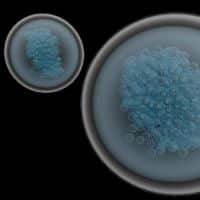By Dr. Ron Shane, Karan Pandher, and Justin Tang
This conference was exquisitely well organized with researchers who are engaged in non-clinical scientific research, pertaining to aging. Unfortunately, the thematic focus of this conference was the recapitulation of scientific protocols, which have limited clinical relevancy in terms of tempering or reversing the aging process. Dr. Brian Kennedy, the CEO and leading researcher at the Buck Institute, involved with sophisticating aging studies, discussed the topic related down-regulation of the Mtor pathway associated with muscle genesis.
It has been pointed out by others that this theoretical model may be efficacious in terms of extending lifespan in non-complex multiple cellular organisms which have a limited lifespan, but it has no real relevance in the human phenotype. It appears that Dr. Kennedy’s strategies may be appropriate in a similar manner to that of caloric restriction to species which are significantly lowered down to phyla, but it is difficult to attempt to make these protocols applicable to humans. Kennedy’s argument could be relevant if a clinician was compelled to extend life in a nursing home. There is evidence that the human phenotype who is seeking quality of life would be motivated to upregulate the Mtor pathway which engenders muscle genesis, and this is necessary to sustain robust physical performance in the older phenotype.
Fragility syndrome and sarcopenia are devastating morbidities associated with aging, which severely tempers the quality of life. Dr. Kennedy discussed the utilization of rapamycin for enigmatic age reversal. This therapy has a litany of side-effects; and has never produced any auspicious clinical outcomes with respect to the tempering of aging. It has failed in many studies to mitigate systemic inflammation and osteoarthritis. In addition, it is not tolerated by human subjects.
There are over a billion humans in the global community over the age of 60 who are desperately seeking viable clinical strategies to increase quality of life. The development of drugs to target specific cellular receptors in certain cell lines have been problematic for a vast array of diseases; and do not appear to be relevant for anti-aging therapies. The optimism that the aging global populace will have a clinical effective therapy to reverse aging or temper this ubiquitous pathogenic disease will not be possible if the ignominious theology of medical science is not radically overturned.
Caloric restriction has been shown by many researchers not to be a viable strategy for humans. It is appropriate for simple multiple cellular organisms. Extreme caloric restriction for humans is fraught with a bevy of side effects, and is not well tolerated. It is estimated that the majority of humans who are older in the US are pathophysiologically overweight. Caloric restriction has ostensible side effects in terms of severely reducing the capacity to robustly exercise, and could induce virulent sarcopenia. It is a problematic protocol which could attenuate the quality of life in the aging human phenotype. Furthermore, older humans need sufficient striated muscularity in order to efficaciously exercise which does induce optimal quality of life. In general, inordinate caloric restriction is a problematic strategy for older humans. Weight loss and ardent exercise conditioning regimes are a much more viable strategy to enhance quality of life, and mollify the pathogenesis related to many age related maladies. There was no discussion at this conference on the importance of robust exercising in terms of enhancing the quality of life, as well as extending lifespan.
Dr. Amy Wagers from Harvard University lectured on some of the early findings of Conboy and Rando’s work on heterochronic parabiosis. She has replicated many of their successful mouse studies. Dr. Wagers asserted that the cytokines from younger mice had a medicinal effect on older organisms. There is a special interest in the GDF-11 protein which is related to myostatin or muscle genesis upregulation, which is then modulated by follistatin. Dr. Wagers purported that this protein is upregulated in older mice and is only one factor which effects muscle genesis.
Dr. Wagers argued that plasma exchange involving a younger human donor to then be utilized by an older phenotype would have very limited clinical utility as well as being extremely painful and expensive. Mouse heterochronic parabiosis studies involves a continual plasma exchange and monthly treatments would not be very effective to mitigate the human aging process. Dr. Wagers asserted that it is most likely necessary to employ cytokines from nascent stem cell sources in order to activate the transcription of genes, which are quiescent in the older mouse phenotype. Dr. Wagers has not used flow cytometry or mass spectrometry to analyze differences in peptides and growth factors in a younger mouse compared to an older phenotype.
Dr. Jasper lectured on the role of a particular niche environment, and how it impacts the optimal proclivities of stem cells. He discussed the importance of how the specific nature of the gut cultural milieu interfaces with other abject changes in the systemic endogenous environment to negatively impact paracrine signaling of a vast array of stem cells. This scenario can have adverse consequences to cellular systems which are affected by their heuristic stem cells. Dr. Rusty Gage gave a very intriguing lecture on neuroplasticity; and alluded to the fact that the only way to auspiciously treat aging in terms of reversal would be to understand how to change the transcriptional factor matrix in the older phenotype to where cells are inducing protein expression characteristic of a younger phenotype. This particular paradigm is based on how highly differentiated mature cells can be undifferentiated to an embryonic like nature. This meeting has limited clinical utility; and recapitulated topics which have been discerned in the preceding 15 years. However, it was entertaining and worth attending.




